Banyan CNC

As part of its Nouveaux lieux, Nouveaux liens programme, the French National Agency for Territorial Cohesion (ANCT) unveiled 61 new Manufactures de proximité on 18 July.
The Pangloss Labs association is proud to have been selected in the 3rd and final wave to become the only Manufacture de Proximité in the entire French Genevan metropolitan area and the 3rd in the department of Ain.
This is the second label received by Pangloss Labs, which has been a Fabrique de territoire since October 2020! Pangloss Labs is also the only manufacture de proximité with a renewable energy sector.
There are currently 100 third-places with the Manufacture de Proximité label, deployed throughout France.
The "Manufactures de proximité" scheme was launched in July 2021 by the National Agency for Territorial Cohesion (ANCT) and the General Directorate for Business, in conjunction with France Tiers-Lieux, to provide long-term support for entrepreneurs and craftsmen throughout our territories, and to provide impetus, within the framework of France Relance, for a programme of economic and engineering support for third-space production sites.
As a reminder, third-spaces are physical spaces for doing things together (coworking, connected campus, shared workshop, fablab... Third spaces are the new places for social links, emancipation and collective initiatives.
What is a Manufacture de proximité ?
Manufactures de proximité are productive third-spaces, which animate and provide services to a professional community. The aim of these local manufactures is to support local economic activity by enabling craftsmen, entrepreneurs and very small businesses to come together in small local production units and to benefit from services and training. The Local Manufactures will become a resource for local industry in order to relaunch the manufacture of products in France.
The Manufactures de proximité will receive grants of an average amount of 250,000 euros over two years to help them invest in local production machinery and equipment to improve their manufacturing capacity, consolidate their business model and purchase equipment for their professional community. The selected Local Manufactures all benefit from an engineering programme that has two components: A four-month incubation phase for project leaders to consolidate the project presented; a two-year tailor-made support phase for each factory, once the funding has been granted, to accompany the implementation of each project. This support aims to create a local economic dynamic and to encourage the promotion of trades, skills and know-how.
Manufactures de proximité are at the heart of the revival of business through territories and the revitalisation of territories through business. I have long defended these third-spaces that bring together VSEs, SMEs and craftsmen around sectors, objectives and values of the future, anchored in people's daily lives. These first 100 labelled structures contribute to our economic sovereignty: they must therefore inspire new ones
Manufactures de proximité are unique places where production tools and techniques can be shared, and they help to create a new economic and social dynamic in our territories. They are a lever for promoting our unique heritage and know-how. Our territories are a wonderful breeding ground for initiatives: I am delighted that these first 100 manufactures de proximité are helping to revitalise them!
"Facilitating access to a world of possibilities".
This is the raison d'être of Pangloss Labs, a non-profit association created in 2014. The mission of the association, based in Ferney-Voltaire in the Pays de Gex (Ain), is to create laboratories for experimentation and prototyping to support local entrepreneurial activities.
Pangloss Labs is a third-space that offers easy access to multiple physical spaces to share and pool tools, machines and workspaces, and provide opportunities for collaboration on different projects. Currently, we offer a Fablab, a Coworking space, and a shared wood workshop (the Woodlab), and are developing a metal workshop (the Metal lab) in beta test. The Pangloss Labs association has about 100 members with various skills. They include professionals (engineers and scientists, designers, creators, artists and entrepreneurs), but also students, retirees and passionate amateurs. By offering production tools, machines and professional skills that are simply not available elsewhere in the Pays de Gex, Pangloss Labs has a lighthouse role and thus responds to a need of companies, social actors and citizens of the territory.
Our action plan as a "Manufacture de Proximité" foresees the increase of the manufacturing capacities of our Fablab, the development of a professional services pole to support local companies and the development of professional training activities.
We are developing cross-border cooperation with various universities and schools: USMB, UNIGE and HEPIA. We are providing prototyping and experimentation support for the new renewable energy eco-system that is being developed in and around Hotspot, the first building of the Ferney Genève Innovation project.
Guillaume Cabrié, co-founder of Pangloss Labs and co-director of the Fablab, said: "We have already helped hundreds of local entrepreneurs with their businesses and increased the number of digital fabrication machines in the region. This award is recognition of this and will help us to move quickly to the next stage, making more and better products right here in France. "
For more information, see our Manufacture de Proximité Project or contact us.

 and 2x headset mics like this
and 2x headset mics like this











Pangloss Wood Lab is a 90m2 shared wood workshop that offers professional woodworking machines to association members. It is located in the center of Sergy (01610) in the Pays de Gex. The workshop exists as a complement to the Pangloss FabLab in Ferney-Voltaire. The workshop is accessible seven days a week, but the large (noisy) machines can only be used during the hours regulated by the municipality of Sergy. All the tools, except the digital machines, are made available with the workspace and included in the prices. Pangloss membership - annual 40 Euros Unlimited Wood Lab workshop access for one month - 60 Euros Unlimited Wood Lab workshop access for 12 months - 500 Euros COVID-19: Please bring a facemask. Maximum 5 people inside. WoodLab

Pricing:
We have a range of different machines in the woodlab, suitable for different types of project, from hobbyist to professional. We do not (yet) sell material for making your projects, but may have small scrap/leftover pieces for testing. Before using a machine, you will need to be trained by the lab manager. Use of machines is on a first come first served basis. Hand tools, and portable electric tools are also available. Members must supply their own wood, sandpaper and glue.
Pangloss membership - annual 30 Euros
Wood Lab workshop access - 5 Euro/hour per pack of 10 hours (valid for 6 months)
Unlimited Wood Lab workshop access for one month - 50 Euros
Unlimited Wood Lab workshop access for 12 months - 500 Euros
Send an email directly to the woodlab team
What is a fab lab?
Fab labs are a global network of local labs, enabling invention by providing access to tools for digital fabrication
What’s in a fab lab?
Fab labs share an evolving inventory of core capabilities to make (almost) anything, allowing people and projects to be shared
What does the fab lab network provide?
Operational, educational, technical, financial, and logistical assistance beyond what’s available within one lab
Who can use a fab lab?
Fab labs are available as a community resource, offering open access for individuals as well as scheduled access for programs
What are your responsibilities?
safety: not hurting people or machines
operations: assisting with cleaning, maintaining, and improving the lab
knowledge: contributing to documentation and instruction
Who owns fab lab inventions?
Designs and processes developed in fab labs can be protected and sold however an inventor chooses, but should remain available for individuals to use and learn from
How can businesses use a fab lab?
Commercial activities can be prototyped and incubated in a fab lab, but they must not conflict with other uses, they should grow beyond rather than within the lab, and they are expected to benefit the inventors, labs, and networks that contribute to their success
Lalliard (Bonneville)
Mauris bois (Annecy)
Corabois (Geneve)
Jumbo (Geneve)
Bordet
Dictum
Manomano
Metiers et Passions
https://www.metiers-et-passions.com
L’air du bois
3D printed door handle extendersThese are designed to make it so doors can be opened with arms instead of hands - reducing the spread of COVID19. Materialise have created an open source collection of designs for different types of doors. These take 2-4 hours to 3D print. |
|
 |
3D printed door openersthis time so a person can carry it from door to door and not have to touch them with their hands to open it. Thingiverse has a collection of designs. These take roughly 30 minutes to 3D print. |
 |
FacemasksMaking filters for facemasks is a simple process of cutting the correct shape from the appropriate filter material. In the event that facemasks and the proper materials are really not available, studies have been done to find "last resort" replacements For cloth facemasks, you don't really need a fablab. Scissors and a sewing machine will work fine. |
 |
3D Printed FacemasksMany enthusiastic 3D printing communities have designed and printed facemasks on the grounds that they are better than nothing. . There are a number of different designs from HEPA filter based, to simple frames for a cloth mask. It's impossible to choose which ones would be useful locally, but if there are clear local needs, there are plenty of open source designs available for us to use or modify. |
 |
Face shieldsIf masks are not available, then face shields can protect medical staff against direct droplet infection - like from a cough. Face shields can be laser cut from clear plastic which is much faster than 3D printing. There are even designs which use A4 plastification sheets. |
 |
VentilatorsIn a more serious pandemic situation, we could certainly provide small scale production of open source ventilator designs to help patients breathe. |
Oxygen concentratorReprap has started work on an open-source Oxygen Concentrator. |
|
 |
Valves and other complex partsThere has been at least one case where a hospital in Italy has had valves for reanimation devices 3D printed when they weren't available from the supplier. We have machines in our fablab that can do this. |
"If you need us, we will help".If any of this will help you, contact us at fablab[at]panglosslabs.org and we will be in touch to discuss your precise needs. And if it turns out that we have all the medical equipment we need, so much the better, we will stay home like everyone else.

The shared working space is a professional, yet inviting spaces that acts as a catalyst for professional exchange and collaboration consisting of:

Faire un don : https://www.helloasso.com/associations/pangloss/collectes/velo-a-hydrogene/don
Nous voulons inciter l’utilisation d’hydrogène vert par les particuliers et ainsi promouvoir les énergies renouvelables.
Nous voulons créer, dans le Pays de Gex et le Bassin Lémanique, une première cellule de compétence autour de l’hydrogène complémentaire de l’électricité verte.
Nous voulons contribuer à développer la mobilité douce dans le grand Genève, notamment dans un territoire très impacté par les déplacements pendulaires frontaliers relativement courts.
Pangloss Labs est très engagé dans des projets pour initier l’économie de l’hydrogène, notamment dans le Grand Genève, à travers ses activités dans le cadre d’Open Geneva, sa participation à la Fête de la Science et au Mobility Hub du Grand Genève
 |
 |
 |
| Harald Wirth | Klaus Röhrich | Olivier Eugene |
| Physicien qui rêve de la transition énergétique vers l’hydrogène vert |
Physicien avec idées et idéals |
Ingénieur passionné des vélos |
Nous avons accompli des recherches préliminaires, regardé ce qui est sur le marché et visité des entreprises et participé à des salons. Nous avons réalisé la conversion d’un vélo « normal » en vélo électrique, en « hackant » des pièces disponibles dans le commerce (p. ex pour outils de jardin).

Les fonds nous permettrons d’aboutir, dans une année, à un prototype d’un vélo à hydrogène suivant les étapes suivantes :

Tous donateurs seront mentionnés dans les publications du projet et invités lors d’une démonstration publique. Vous êtes tenus au courant des développements, événements et plus encore !
Vous recevrez également une message sur nos médias sociaux pour montrer au monde entier à quel point vous êtes un être humain conscient et généreux !
Faire un don : https://www.helloasso.com/associations/pangloss/collectes/velo-a-hydrogene/don

Because of the need of storage for renewable energy, hydrogen is on the way to becoming a popular means of storing energy in large quantities. This hydrogen is available either for back-conversion into electricity or for direct use as in hydrogen cars or, as in this case, to power a bicycle. With our kit for converting a traditional bicycle into a hydrogen-powered electric bicycle, we want to bring hydrogen to broad public. We want to make it common, we want to get used to its use with an application that is affordable and available to everyone.
Hydrogen is clean provided it is produced from renewable resources with appropriate technologies. This is the case of hydrogen produced by electrolysis with green electricity. So it is the consumer's choice.
Hydrogen is no more dangerous than gasoline or natural gas. The charateristics of combustion and therefore of a possible explosion of these fuels are different. Hydrogen is the lightest of all these molecules and the impact of an improbable explosion is less important. With modern handling and storage equipment, the risk of a leak or explosion is very low.
First of all, in hydrogen we store more energy than in electricity. So the autonomy of a vehicle, car or bicycle or bus, is considerably increased.
Existing hydrogen bikes have a high level of component integration. They are expensive not only because of the cost of the components, but also because of the cost of their manufacture and the amortisation of the development. With an open source kit, the user only has the costs of purchasing the hardware. With the conversion kit turning a traditional bike into a hydrogen-powered electric bike, the H2 bicycle becomes much cheaper and therefore affordable.
We are Pangloss volunteers, philanthropists, who take pleasure in developing something useful. Our hope is to get feedback on ideas to improve the system. But our biggest interest is to get as many users as possible enthusiastic about the system so that suppliers can commit to making better and cheaper components.
They have seen hydrogen-powered bicycles for about 20 years. They were prototypes or small series reserved for industrial users and public organizations. With the kit, we open the door for the private individual.
Hydrogen supply is a concern. There are recharging stations for example by Ataway in Chambery, or the hydrogen cartridge distribution system from Aaqius in Paris and Geneva. With the proposed kit we give them the motivation to create a regional charging network. If not, there is the possibility to install a small electrolyser at home. This is a relatively expensive, but available solution.
Today we buy components for the kit, electric motor, fuel cell, hydrogen storage, microcontroller, tubes, fittings and cables for about six to seven thousand euro. The projected price of the components, scaling with increasing production numbers, allow us to speak about a price for the kit in the order of 1000 euro.
On a bicycle you typically store 50 grams of hydrogen. This is 60% more energy than stored on an electric bicycle. Based on the price of one kilogram of hydrogen of ten euro, as for hydrogen cars, the cost of recharging is half a euro.
We want to encourage the use of green hydrogen by private individuals, and thus promote renewable energies. We want to create, in the Pays de Gex and the Lake Geneva Basin, a first centre of competence around hydrogen as a complement to green electricity. We want to contribute to the development of soft mobility in the Greater Geneva area, particularly in an area that is heavily impacted by relatively short border commuters' journeys.
As technical people - Harald and Klaus are physicists, Olivier is an engineer - we are naturally interested in new technologies. Our concern for the climate, the environment and the sustainability of our social system has led us to think about renewable energy applications and hydrogen. At Pangloss Labs we have found a favourable environment and an atmosphere nourishing our ideas.
In order to buy components and build the hydrogen bicycle, we need a budget of about 15 thousand euros. Hydrogen-related components, fuel cell, hydrogen container, bottle with refill system, tools and accessories will consume 85 percent of these funds. We have included a small amount for travel for meetings with potential partners. The rest is used for consumables and contingencies.
Making the hydrogen bicycle is a Pangloss Labs project. It is, therefore, supported by the association. The project has already received funds to buy an electric motor, which has been installed on the bicycle that was donate by one of the members of the association. At Pangloss there is furthermore the possibility of rent workshop space in the FabLab. The project is lead by Klaus Röhrich, Harald Wirth and Olivier Eugene.
A brief history of hydrogen-powered bicycles, or simply hydrogen bike or H2 bike. The information and images are the result of research on the Internet between October 2018 and February 2020. Sources are added at the bottom of the document. Certainly, this story is not perfect, but it gives a good impression of past projects.
Klaus Röhrich, Pangloss Labs, March 2020
The first hydrogen-powered electrically-assisted bicycles were built in research enviroments.
 |
The US-American "Hydrocycle" by Manhattan Scientifics with a German 670W PAC from NovArs was presented in 2000. |
 |
At the same time in Rome, Italy, ENEA was also working with hydrogen. Their small SCENIC 150 system (Sistema Cella EneaNuvera a Idrogeno Combustibile da 150 Watt) was used to assemble a hydrogen bicycle. |
 |
A little later, the Italian bicycle manufacturer Aprilia SpA took up the idea. As a professional bicycle manufacturer it redesigned the Hydrocycle of Manhattan Scientifics and built the first commercial hydrogen-powered bicycle. The Aprilia Enjoy Fuel Cell Bike was presented in 2001 with a 300 bar composite hydrogen storage cylinder. This H2 bicycle was called "An Invention of The Year" by Time Magazin on November 13, 2001 (article). |
 |
As an anecdote from this pioneering period, student Jörg Weigl from the University of Ulm in Germany broke the autonomy records for H2 bikes. With his recumbent bike construction he cycled 1200 kilometres during the Wasserstoff-Expo in Hamburg 2002.. |
The company Aprilia became quiet about its H2 bike around 2005. There was the American WL Gore & Associates who presented an evolution of the bikes of Manhattan Scientifics and Aprilia at the Fuel Cell Expo 2005 in Japan, but without any commercial success.
But the idea was disseminated. Universities, research centres and enthusiasts immersed themselves in the world of hydrogen, fuel cells and bicycles. Here is a review of the achievements.
Since its first prototypes, ENEA in Rome has not stopped developing hydrogen bicycles. Their 2009 model worked with a fuel cell of only 50W (6V x 8.5A) with 900 litres H2 on board. The autonomy was thus more than twice that of a conventional pedelec. Or, on the occasion of the Formula E Grand Prix to be held in Rome in April 2019, ENEA participated with a hydrogen bicycle in the E-Parade of ecological 2, 3 or 4-wheel vehicles.
 |
 |
 |
| ENEA 2000 | ENEA 2009 | ENEA 2019 |
 |
Since 2008, a hydrogen bicycle was developed in Australia. The University of New South Wales built the H2 bike with a first prototype running in 2014 and a second one, the Hy-Cycle 2.0 in 2016. |
 |
In Italy, Vincenzo Antonucci in collaboration with TRE SpA (Tozzi Renewable Energy) and CNR-ITAE (Messina) presented his 26 Kg H2 bike at the "H2 Roma Energy & Mobility Show" in 2009. |
 |
In 2012, Trifyl surprised with their hydrogen-powered bike. This prototype was designed by Trifyl, the Departmental Service for the Recycling of Household Waste in the Tarn, in collaboration with the Ecole des Mines d'Albi and Albhyon, which specialises in hydrogen. Presented during a stage of the 2012 Tour de France, this bike was not, however, commercialized. |
 |
Also in 2012, at the Hochschule RheinMain, a prototype was built by Michael Röser, Stefan Dietrich and Georg Derscheid based on a Sustamo bicycle. |
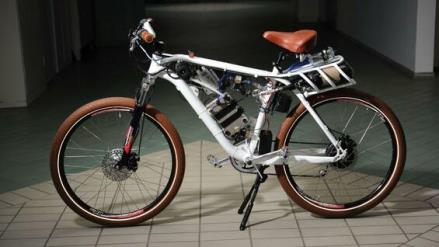 |
The development of the Gernweit Ped-Hy-lec bike began in 2008. The business consultant Holger Hanisch was supported by the Department of Hydrogen and Fuel Cell Technology of the University of Applied Sciences RheinMain, in cooperation with Ralph Luh Engineering Co. and Schunk Bahn- und Industrietechnik GmbH (all in Germany). The hydrogen bicycle had been developed until 2014. Its weight was 34.6 Kg and its price was somewhere above €7'000. |
Besides the more traditional bicycles, in 2012 futuristic prototypes were conceived by visionaries. Examples are the design model by the Swede Johan Persson for Aprilia, or the “Hydogenia”, a hybrid between pedelec, rickshaw and fuel cell from IFAM (Fraunhofer Institute for Manufacturing Technology and Advanced Materials), Dresden.
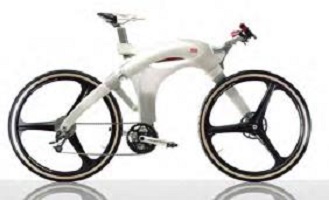 |
 |
| Johan Persson’s Aprilia, 2012 | Fraunhofer E-Bike Hydogenia, 2012 |
More recent are the prototypes of Vorradler (Germany 2014), Tc Mobility (Italy, 2015), Alex Bevan from Birmingham University (United Kingdom, 2017) with H2 internal combustion engine or the bicycle by Ankica Đukić at the University of Zagreb (Croatia, 2017).
 |
 |
| Electrolyte Vorradler S3 FC, 2014 | Tc Mobility Frisbee «Scoobi» H2, 2015 |
 |
 |
| Alex Bevan, Birmingham University, 2017 | Ankica Đukić, University of Zagreb, 2017 |
The Deutsches Zentrum für Luft- und Raumfahrt (DLR) developed a pedelec shown in 2014. This bicycle is now in their museum. DLR also developed a cargo bike. The technology is now exploited by Rytle GmbH in Hamburg, Germany.
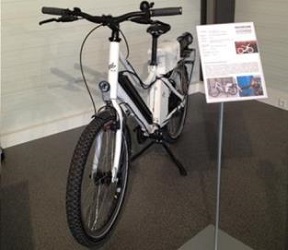 |
 |
| DLR BZ-Rad, at the DLR museum | DLR Cargo Bike, 2015 |
At the Fraunhofer Institute ISE in Germany the LiteFCBike had been developed since 2016. This complete fuel cell system with hydrogen storage in twelve metal hydride cartridges and buffer battery can be mounted on any electric bicycle replacing the battery. In combination with an electric bike conversion kit almost any bike can be converted into a hydrogen bike. The energy stored with the kit is about 270Wh, so only half of a standard pedelec battery (about 500 Wh).
 |
 |
| Fraunhofer ISE, 2016 | the hydrogen pack |
| We have not found any more information about the MicroBike E-go Hydrogen, advertised on the internet in May 2019 with a price of €4'500. |  |
| In November 2004, Palcan Fuel Cells Ltd. of Vancouver, Canada inaugurated its first assembly line at the Shanghai Tongji Nanhui Science and Technology Industrial Park and partnered with Nanjing Fuel Cell Company Ltd. Eventually, Palcan abandoned this business. In 2009, Palcan supplied a 300W PAC to the Chinese company Shanghai Giant & Phoenix Bicycle to power a hydrogen-scooter. |  |
The German Masterflex AG had a little more success. Suppliers of fluid handling components and analysis systems, Masterflex began to get involved in the PACs business in 2001. The prototype of its HyBike with a 250W PEM and 45 grams of hydrogen on board was shown at the Hannover Messe 2004. In 2007, the city of Herten in Germany, a champion in the application of green technologies, bought ten HyBikes for €70'000. The hydrogen was to be supplied by its "Blue Tower" factory, but apparently there were technological problems. In the meantime Masterflex built the CargoBike together with the German bicycle manufacturer Hawk Bikes Entwicklung & Marketing GmbH. The Deutsche Telekom tested 14 CargoBikes in Berlin in 2008. There was no follow up from these prototypes, and in April 2011 Masterflex announced that it had divested its bicycle business.
 |
 |
| Masterflex HyBike, 2004 | Masterflex Cargo Bike, 2008 |
| Palcan's bike has had a successor in China. In 2007 Shanghai Pearl (Shanghai Pearl Hydrogen Power Source Technology Company) presented its "Hydrogen Fuel Cell Powered Bicycle PHB". This bicycle weighed 32 Kg. Its price was estimated at $2,650 with a projection of $350 for mass production. |  |
Valeswood ETD Ltd. in Birmingham, UK, used Shanghai Pearl technology to create its own hydrogen-powered bicycle in 2007. Since 2010, Valeswood ETD Ltd. seems no longer in business.
 |
 |
| Valeswood 2007 | Valeswood 2010 |
| Another derivative of the Shanghai Pearl bicycle was marketed somewhat later by the Italian company Acta SpA. The company presented its first prototype in September 2009 at the EICMA Motor Show. The Acta bike would be used to gain experience, for example in Spain by the Fundación para el desarrollo de las nuevas tecnologias del hidrógeno en Aragón and the CCI Instituto Tecnologia de Canarias in Pozo Isquierdo, Gran Canaria, Islas Canarias. However, Acta has since abandoned this application to concentrate on the development of electrolysers. |  |
| Similar to the bikes of Shanghai Pearl, Valeswood or Acta was Iwatani's bicycle. Iwatani Corporation developed hydrogen-powered electrically-assisted bicycles between 2006 to 2008 participating in the Japan Hydrogen & Fuel Cell Demonstration Project (JHFC). The outcome was presented at the Kansai International Airport in October 2009. |  |
| Also in this category of small bikes falls that of Pedego Electric Bikes. This Californian company was working with SiGNa Chemistry in the development of a range extender for their electric bike Pedego Classic Comfort Cruise. "For every 1.5 lbs. of weight a rider carries, an additional 700 Wh is available (compared to ~350 Wh for an ultra-high performance lithium-polymer battery at a weight of 7 lbs.)." |  |
| At the same time in Austria and Germany, the company Linde at Vienna, Austria, a supplier of industrial gases and technology, was active in the field. A pilot series of one hundred hydrogen-powered bicycles was produced and distributed to institutional and political users in 2015. The bike weighs only 23.6 kg with a price tag above €7'000, but Linde is not interested in marketing it. | 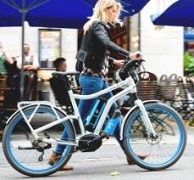 |
The French company Gitane (Cycleurope Group) presented its prototype hybrid called Alter Bike in Nice in May 2013. It had been developed in collaboration with the French companies Pragma Industries and Ventec. The hydrogen is stored in interchangeable and recyclable metal-hydride capsules. The Alter 2 bike appeared in 2016.
 |
 |
| Gitane Alter Bike, 2013 | Gitane Alter Bike 2, 2016 |
The hydrogen bicycle αlpha is a development of Pragma Industries (Biarritz, France). The project is supported by ADEME. Pragma Industries had presented a prototype in 2015. These bicycles weigh 25 kg, comparable to the weight of an electric bicycle. They were given a price tag of €7'000, with the prospect of reducing the price to €3'500 by 2020. There are several projects using the αlpha such as the CARGHO project, which is a fleet of hydrogen bicycles tested by users in Chambéry and at Savoie Technolac, or also the Bhyke project in Cherbourg and Saint-Lô in the Manche with a fleet of 20 bicycles. Pragma Industries has also unveiled hydrogen eTrikes for the last meters in the delivery chain.
 |
 |
The MovR cargo bike by Rytle (Bremen, Germany) has been on the market since 2018. The company is a spin-off project of DLR's Fuel Cell Power Pack (FC PP).

Atena Scarl is the high-tech centre for energy and the environment in Italy. Its flagship technology is a small fuel-cell system that is put on hydrogen-powered bicycles, scooters and micro cars. The systems are equipped with interchangeable cartridges or can be recharged independently. The hydrogen bicycle is supported by ENEA, Università Parthenope di Napoli and Università degli Studi di Perugia. In 2019, three models were available: Touring 250, Sport MB250, Sport MB500, but without price or point of sale.

In September 2019 CYCLEUROPE and STOR-H presented the Gitane Sneaker, a hydrogen-powered three-wheeled bicycle. The electric motor has a power of 250W. Two metal hydride cartridges provide a range of 50 km. The company Aaqius, supplier of the returnable cartridges, plans to create a local network of distributors.
List of the most important web pages visited, almost complete, in alphabetical order :
blog.wired.com/gadgets/2007/05/fuel_cell_cargo.html
blog.wired.com/gadgets/2007/05/fuel_cell_cargo.html
blog.wired.com/gadgets/2007/05/fuel_cell_cargo.html
blue-rocket.de/rytle-vernetzt-lastenraeder-mit-mini-hubs/
bresciapoint.blogspot.com/2009/05/la-mobilita-ad-idrogeno-e-gia-realta.html
en.wikipedia.org/wiki/PHB_(bicycle)
evworld.com/article.cfm?storyid=413
frisbee.eu/blogs/news/19169327-bici-frisbee-a-idrogeno-by-tc-mobility
hydrogen.hr/en/first-croatian-hydrogen-fuel-cells-powered-bicycle
HZwei/blog/2018-12-14/die-letzte-meile-mit-dem-movr
Masterflex: Cargobike with mini fuel cells at Hanover Fair
mhtx.com/history/mid-range-fuel-cell/
microbike.it/Microbike-go%20Idrogeno.htm
old.enea.it/produzione_scientifica/pdf_volumi/V2002_Celle-Combustibile.pdf
phys.org/news/2018-04-hydrogen-aid.html
rideyourcity.wordpress.com/2012/03/22/fuel-cell-cargo-bike-could-power-your-lights-and-tv-too/
www.afhypac.org/documents/tout-savoir/fiche_9.4.4_les_applications_aux_cycles_rev.mai_2015_th.a.pdf
www.afhypac.org/documents/tout-savoir/fiche_9.4.4_les_applications_aux_cycles_rev.mai_2015_th.a.pdf
www.alternative-energy-news.info/hydrogen-fuel-cell-bikes/
www.alternative-energy-news.info/hydrogen-fuel-cell-bikes/
www.alternative-energy-news.info/hydrogen-fuel-cell-bikes/
www.autogazette.de/eco/wasserstoff-fahrrad-203472.html
www.bike-eu.com/home/nieuws/2013/05/launch-of-worlds-1st-hydrogen-fuel-cell-e-bike-1013039
www.bolidenforum.de/artikel/zweirad/65568-fraunhofer-pr%C3%A4sentiert-brennstoffzellen-fahrrad
www.ctsenergy.net/news/from-bolzano-to-hannover-launch-pad-for-smart-mobility/
www.dlr.de/fk/desktopdefault.aspx/tabid-3731/5826_read-41856/
www.dlr.de/fk/desktopdefault.aspx/tabid-6194/13132_read-46816/
www.dlr.de/fk/Portaldata/40/Resources//181_14_025_Flyer_Brennstoffzellen-Bike_web.pdf
www.dlr.de/ra/desktopdefault.aspx/tabid-4058/6636_read-48445/
www.ebiketestsieger.com/e-bike-news/243-weltneuheit-e-bikes-mit-wasserstoff-antrieb.html
www.elektrobike-online.com/news/e-bikes-und-pedelecs/wasserstoff-e-bike-von-linde-elektrobike-beantwortet-die-zehn-wichtigsten-fragen.1480506.410636.htm
www.energieportal24.de/artikel_1211.htm
www.fahrrad-xxl.de/blog/kommt-2019-das-wasserstoff-e-bike-mit-brose-motor/
www.fr.de/frankfurt/wasserstoff-technik-anfassen-11339038.html
www.gernweit.com/hydrogen-e-bike.html
www.gernweit.com/wasserstoff-rad.html
www.hydrogen-motors.com/hydrogen/2010/03/fuel-cell-bicycle-hydrogen-bicycle/
www.hzwei.info/blog/2016/03/14/auch-pedelecs-fahren-mit-brennstoffzellen/
www.hzwei.info/wp-content/uploads/download/HZwei-Juli-2008.pdf
www.ingenieur.de/technik/fachbereiche/antriebstechnik/paketauslieferung-per-wasserstoff-bike/
www.ise.fraunhofer.de/de/forschungsprojekte/litefcbike.html
www.iwatani.co.jp/eng/newsrelease/detail_32.html
www.lastampa.it/2009/11/05/scienza/in-arrivo-la-bici-a-idrogeno-LPntOEPnKlZXZsbyc7Kn5H/pagina.html
www.masterflex.de/com/index.php?news_id=804
www.masterflex.de/unternehmen/historie/2001-bis-2010.html
www.merlin.unsw.edu.au/energyh/hy-cycle/
www.pnp.de/nachrichten/ratgeber/auto_und_motor/sps/3200301_Das-erste-Wasserstoff-Mountainbike.html
www.poweredbicycles.co.uk/Hydrogen-Lion-Bike/G222.htm
www.poweredbicycles.co.uk/Lion-Folding-Bike-With-Hydrogen-Cell/G123.htm
www.pragma-industries.com/products/light-mobility/
www.pragma-industries.com/products/light-mobility/
www.qualenergia.it/articoli/enea-presenta-la-bici-elettrica-a-idrogeno/
www.rad-nr.de/2014/11/22/ein-drahtesel-mit-wasserstoff-antrieb/
www.solarinitiativen.de/wp-content/uploads/1_fr_02_stiller_wasserstoff.pdf
www.treehugger.com/cars/gore-aprilia-fuel-cell-bike.html
www.treehugger.com/files/2007/05/on_yer_hydrogen.php
www.valeswood.com/news/valeswood_newsletter_2010_spring.html
www.youtube.com/watch?v=Ma3CPaWTe90
www.youtube.com/watch?v=P3LPWVMB54k
www.youtube.com/watch?v=PSmH9xHxHc8
www.youtube.com/watch?v=T5wo8AvsSxQ
www.zsw-bw.de/zepeo.fsb.hr/blog/2017/07/07/ankica-dukic-presented-her-hydrogen-bicycle/
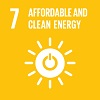
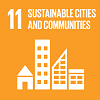
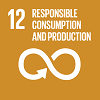
We want to co-create a conversion kit «open source»
to transform classical bicycles into hydrogen powered electric bicycles.
Who we are ?
The project "Kit pour Vélo H2" is a project of Pangloss Labs association at Ferney-Voltaire, France. The project is one of the many co-creation projects of the members of the association.
Raison d’être : Promote green hydrogen at fair price to promote the use of renewable energy.
Hydrogen is not easily available to the individual. Today, use of hydrogen is confined to
• subsidized projects which are run by the supplyer of the hydrogen equipment,
• particular applications like vehicle fleets , and
• trained guided users like La Poste.
In this environment we lack the opportunity for doing something ourselves, for using hydrogen in our daily life. With the concersion kit for the hydrogen bicycle and a viable hydrogen distribution available, we start into a new phase in the evolution of the hydrogen economy, the one that includes the common person.
Vision
An economy in which it is easy to get green hydrogen, even in small quantities and at affordable price, for individual use p.ex. to heat, to cook or -as is presented here - to move around on a motor assited bicycle.
Mission : Promote the use of renewable energy (“appellation hydrogène verte”).
Our primary goal is the creation of a kit to convert a standard bicycle into an electric bicycle powered by hydrogen. Making a prototype will serve to raise funds for the next stage.
The second goal is proposing a regional hydrogen infrastruture which is appropriate for the needs of the cyclists, and which is easy to copy and implement elsewhere.
Batterie or hydrogen power for the electric bike ?
For short rides in town, the electric bicycle is a good solution. But when you need to move over larger distances for example in the coutnryside, the electric bike's range is often too shorts. In particular commuters between a home in the outskirts of the city and a job inside can be disadvantaged by the autonomy limited by the energy stored in the battery. With hydrogen, the range of an electric vehicle can be much larger, because more energy can be stored in comparison to batteries.
Why hydrogen ?
To achieve our environmental and climate goals we must reduce CO2 emissions massively and utilise the advantages that come with renewable energies. For the storage of renewable elecricty produced with photo-voltaic panels or wind power generators, hydrogen is being established as a primary storage medium. Surplus energy is transformed into hydrogen - rather than being discarded - which thus is available not only for reconversion into electricity but also for direct use in a multitude of applications, in particular in individual mobility. Such hydrogen is truely green as it does not impact patterns of consumption like it is the case of electricity when renewble energy for transport cuts into the supply of renewable energy to other sectors.
Why Open Source ?
The use of hydrogen applications is generally confined to organizations and professional users. One of the obstacles is the cost of the equipment. With an open source development of the conversion kit the invidual users can construct his or her own hydrogen bicycle at the cost of the components only. This entails larger numbers of users and in turn cheaper components. Feedback from users will accelerate the development.
Fuel cells exist. We need to find the right fuel cell for use on the bicycle.
We need to find appropriate, i.e. cheap, light and compact hydrogen storage either as compressed gas in a bottle or dissolved in a metal hydride container.
We need to create the hydrogen infrastructure (storage container leasing, vending machines, centralized or individualized recharge) ?
questions FAQ
During the Open Geneva Innovation Festival 2018 a group of Pangloss members and others assembled to think about how to introduce hydrogen as a clean energy vector in our society. Various ideas were aired. A condensation took place for the Fête de la Science in Ferney-Voltaire half a year later. One of the concepts put forward was that of bringing hydrogen bicycles to the people. Two workshops (hackathons) on the subject followed in January and March 2019.
The hydrogen powered electric bicycle (HPEB) is not a new idea. Already 20 years ago such vehicles were constructed, but they were never made available to the common person, not to talk about production in series. The latest version, the Alpha bike of French company Pragma Industries is produced in batches of a hundred units and distributed to users, usually organizations, who can afford the rather hefty price of the bicycle of the order of 7'000 euros and the massive cost of a refilling station upwards of 50'000 euros.
At Pangloss Labs we have the idea to make all this cheaper with the goal to enable everybody profitting from green energy and clean hydrogen thus making a measurable contribution to a more sustainable world.
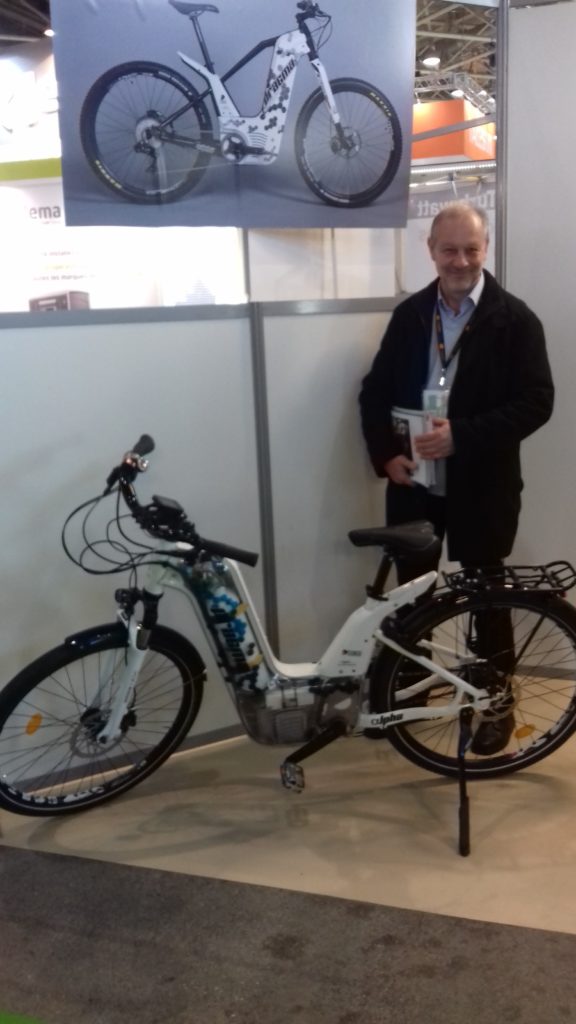
Our concept turns around the creation of a kit for converting normal bicycles into hydrogen powered electric bicycles (HPEB). Such kits should be cheap. The HPEB should not cost more than the equivalent electric bike but - and this will be the major advantage for the cyclist - with much larger autonomy. We think that eventually we can store 50 grams of hydrogen on the bike, which is equivalent to 750 Wh using a decent fuelcell, 50% more energy than typically stored on an electric bicycle. Bigger hydrogen containers and more efficient fuel cells will soon bring the advantage to 100% doubling the autonomy.

 The Saxifrage 3 axis Mini CNC machine is a small, solid 1610 CNC using GRBL firmware and OpenCNCPilot control software. It is specifically for milling prototype PCBs.
Machine Status: Working
(more…)
The Saxifrage 3 axis Mini CNC machine is a small, solid 1610 CNC using GRBL firmware and OpenCNCPilot control software. It is specifically for milling prototype PCBs.
Machine Status: Working
(more…)Designing and creating objects that connect to the Internet and each other. Mostly based around raspberry pi, openhab, mqtt, and Arduino variants. Includes programming, hardware design, and our smartlab based on openhab allows experimentation with more than 300 different IoT protocols! Recent additions to the lab include LoraWAN for remote IoT sensors, NFC and RFID tag technology and more. This is the place for AI, bots, dataviz and things generally interacting with the internet and the real world.
Send an email directly to the IoT Lab team

Learn about the world of 3D printing from one of our fablab experts. In this introduction course you will learn the basics of 3D printing and how to use a filament-based 3D printer, including the all important first print.
This is a two hour course including hands on exercises with a Pangloss expert.
At the end of it you will be able to use the Pangloss Labs 3D printers, and be much more expert with your own 3D printer at home or work.
The course includes:
No specific knowledge is needed for this course. Your technical ability should be "can click a mouse".
Bring a laptop computer or tablet if you can. If not, you can use one of ours. We will use open source software "Cura" on this course so if you like you can install it on your computer before you come.
This course is available on demand and take place in the Fablab in Ferney-Voltaire. Fill in the form below to indicate interest and we will arrange a date to suit you. Payment is only due once the date has been arranged.
This course is available in both English and French.
Pangloss collaborates with specialists to organise and host a variety of conferences and courses, with the aim of supporting innovation and entrepreneurship in the greater Geneva area. For example:
The shared working space is a professional, yet inviting spaces that acts as a catalyst for professional exchange and collaboration consisting of:


 Vous vous êtes certainement posé les questions suivantes sur la beauté
«Qu’est-ce qui est beau ? »
«Comment être beau? Existe-t-il une méthode, une recette pour faire du beau ?»
«Pourquoi moi je trouve ça beau mais pas les autres ? »
Un proverbe arabe dit : « la beauté est dans l’œil qui regarde ». En fait la réponse de notre être à l’esthétique, est purement personnelle, et dépend de nombreux facteurs culturels et émotionnels.
La beauté d’un visage par exemple peut être appréciée comme une absence de défaut. C’est la beauté qui rassure quant à son vécu personnel. Mais au contraire cela peut être une aspérité qui étonne au lieu de susciter notre rejet.
Dans la réponse esthétique, on trouve le plus souvent une émotion qu’il est difficile de comprendre pour soi et encore plus d’expliquer aux autres.
Un jour j’ai découvert l’univers de l’espace mathématiques de Mandelbrot. D’abord subjugué par la richesse des images produites à partir d’un simple zoom sur un point particulier de cet espace, où les formes se répétaient avec des variations étonnantes, je me suis fait expliquer ce qui générait ces formes.
La réponse était étonnante. La fonction génératrice était l’étude de suite, dans le simple plan des complexes, dont on étudiait la vitesse de convergence.
On donnait une couleur au point à partir duquel la suite était calculée, en fonction de sa vitesse de convergence.
Un élève de terminale peut comprendre le problème posé, cependant la question est bizarre, originale. La réponse à cette question est, elle, époustouflante.
Si Benoit Mandelbrot avait gardé pour lui le secret de cette génération en ne divulguant que le résultat artistique de ses recherches, jamais on aurait compris le principe générateur de ces formes d’une richesse infinie.
Cela choque beaucoup de personnes, mais de nombreux mathématiciens pensent que tout est nombre. Le réel physique d’existerait pas et l’univers ne serait que le résultat de perceptions diverses.
En décomposant, la complexité on arrive à de simples fonctions primitives, finalement assez pauvres.
Jeune étudiant j’avais été choqué par l’énoncé du théorème de Fourier.
Ce théorème dit que tout signal cyclique, aussi complexe soit-il, peut se décomposer en une somme de vibrations à différentes fréquences.
Une vibration est une simple vague qui fait monter et descendre de façon continue, répétitive et monotone.
La vibration en tant que cycle rassure, car on sait qu’après être redescendu, on va remonter, puis redescendre. Ça ne finit jamais et c’est sans surprise.
La fonction mathématique qui porte cette vibration est la fonction Sinus.
N’ayant comme talent artistique que celui du contemplatif, j’ai imaginé des formes qui ne seraient que des sommes de vibrations, dans tous les sens, dans plusieurs dimensions. En les combinant, on génère des formes douces, organiques, qui rappelle des muscles, des viscères, un squelette. On repère quelques répétitions signant la simple vibration, la simple vague, la simple fonction sinus, mais ces répétitions ne se répètent pas complètement à l’identique et surprennent un peu dans leur rendu parce qu’elles sont simplement combinées avec d’autres. On entre progressivement dans le domaine du vivant, ou dans l’illusion du vivant.
Vous vous êtes certainement posé les questions suivantes sur la beauté
«Qu’est-ce qui est beau ? »
«Comment être beau? Existe-t-il une méthode, une recette pour faire du beau ?»
«Pourquoi moi je trouve ça beau mais pas les autres ? »
Un proverbe arabe dit : « la beauté est dans l’œil qui regarde ». En fait la réponse de notre être à l’esthétique, est purement personnelle, et dépend de nombreux facteurs culturels et émotionnels.
La beauté d’un visage par exemple peut être appréciée comme une absence de défaut. C’est la beauté qui rassure quant à son vécu personnel. Mais au contraire cela peut être une aspérité qui étonne au lieu de susciter notre rejet.
Dans la réponse esthétique, on trouve le plus souvent une émotion qu’il est difficile de comprendre pour soi et encore plus d’expliquer aux autres.
Un jour j’ai découvert l’univers de l’espace mathématiques de Mandelbrot. D’abord subjugué par la richesse des images produites à partir d’un simple zoom sur un point particulier de cet espace, où les formes se répétaient avec des variations étonnantes, je me suis fait expliquer ce qui générait ces formes.
La réponse était étonnante. La fonction génératrice était l’étude de suite, dans le simple plan des complexes, dont on étudiait la vitesse de convergence.
On donnait une couleur au point à partir duquel la suite était calculée, en fonction de sa vitesse de convergence.
Un élève de terminale peut comprendre le problème posé, cependant la question est bizarre, originale. La réponse à cette question est, elle, époustouflante.
Si Benoit Mandelbrot avait gardé pour lui le secret de cette génération en ne divulguant que le résultat artistique de ses recherches, jamais on aurait compris le principe générateur de ces formes d’une richesse infinie.
Cela choque beaucoup de personnes, mais de nombreux mathématiciens pensent que tout est nombre. Le réel physique d’existerait pas et l’univers ne serait que le résultat de perceptions diverses.
En décomposant, la complexité on arrive à de simples fonctions primitives, finalement assez pauvres.
Jeune étudiant j’avais été choqué par l’énoncé du théorème de Fourier.
Ce théorème dit que tout signal cyclique, aussi complexe soit-il, peut se décomposer en une somme de vibrations à différentes fréquences.
Une vibration est une simple vague qui fait monter et descendre de façon continue, répétitive et monotone.
La vibration en tant que cycle rassure, car on sait qu’après être redescendu, on va remonter, puis redescendre. Ça ne finit jamais et c’est sans surprise.
La fonction mathématique qui porte cette vibration est la fonction Sinus.
N’ayant comme talent artistique que celui du contemplatif, j’ai imaginé des formes qui ne seraient que des sommes de vibrations, dans tous les sens, dans plusieurs dimensions. En les combinant, on génère des formes douces, organiques, qui rappelle des muscles, des viscères, un squelette. On repère quelques répétitions signant la simple vibration, la simple vague, la simple fonction sinus, mais ces répétitions ne se répètent pas complètement à l’identique et surprennent un peu dans leur rendu parce qu’elles sont simplement combinées avec d’autres. On entre progressivement dans le domaine du vivant, ou dans l’illusion du vivant.

 Mon œil est surpris par le résultat. J’espère que le votre aussi.
Mon œil est surpris par le résultat. J’espère que le votre aussi. On the 12th of January a small, determined group met at Pangloss Labs in Ferney-Voltaire to discuss why there isn't yet a Pangloss Labs Geneva site and what to do about it.
In a nutshell, although we have found some spaces in Geneva that meet our original half office / half workshop criteria, they are very few and far between. With the rent costs being much higher in Geneva than neighbouring France, to replicate directly what we did in France would need 45 people willing to pay a proportion of the rent, before we have the space. In addition, leases in Geneva tend to start at 5 years. With some of the offers we have, on projects under development, we'd need 45 people willing to commit to contribute to a collaborative association for 5 years, starting in 1-2 years time. That's almost impossible to do.
So, with the facts on the table, and with the aid of some decent French wine, we brainstormed on the possible ways forward.
On the 12th of January a small, determined group met at Pangloss Labs in Ferney-Voltaire to discuss why there isn't yet a Pangloss Labs Geneva site and what to do about it.
In a nutshell, although we have found some spaces in Geneva that meet our original half office / half workshop criteria, they are very few and far between. With the rent costs being much higher in Geneva than neighbouring France, to replicate directly what we did in France would need 45 people willing to pay a proportion of the rent, before we have the space. In addition, leases in Geneva tend to start at 5 years. With some of the offers we have, on projects under development, we'd need 45 people willing to commit to contribute to a collaborative association for 5 years, starting in 1-2 years time. That's almost impossible to do.
So, with the facts on the table, and with the aid of some decent French wine, we brainstormed on the possible ways forward.  With lots of whiteboards, and different experiences and backgrounds we came up with the following plan:
With lots of whiteboards, and different experiences and backgrounds we came up with the following plan:
 Geneva, but it does solve the problem of how to get the other Innovation Labs really working for those members unable to easily get to Ferney-Voltaire and it provides something concrete as a partnership with our other innovation space friends around Geneva.
Once things are up and running, we can decide if we need another physical space in Geneva, or if working collaboratively with existing spaces is sufficient.
What do you think?
Geneva, but it does solve the problem of how to get the other Innovation Labs really working for those members unable to easily get to Ferney-Voltaire and it provides something concrete as a partnership with our other innovation space friends around Geneva.
Once things are up and running, we can decide if we need another physical space in Geneva, or if working collaboratively with existing spaces is sufficient.
What do you think? The Primula 3D printer is a modified open source iTopie design with a diamond head triple mixing extruder for providing full-colour FDM printing.
Machine Status: Needs Z axis calibration
(more…)
The Primula 3D printer is a modified open source iTopie design with a diamond head triple mixing extruder for providing full-colour FDM printing.
Machine Status: Needs Z axis calibration
(more…)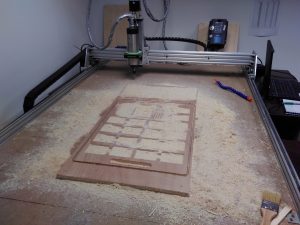 The Oak 3 axis CNC machine is an open source Openbuilds OX CNC using a smoothieboard as it's control system.
Machine Status: Working
(more…)
The Oak 3 axis CNC machine is an open source Openbuilds OX CNC using a smoothieboard as it's control system.
Machine Status: Working
(more…) The Comfrey 3 axis CNC machine is a robust, solid Badog X2 CNC using Mach3 control software.
Machine Status: Working
(more…)
The Comfrey 3 axis CNC machine is a robust, solid Badog X2 CNC using Mach3 control software.
Machine Status: Working
(more…) One hour course Syllabus:
One hour to know if Design Thinking is for you.
In one hour, we will share with you the mindset and the key things for you to know if design thinking can help you.
We believe it will ! Come and see us to find out how this will boost your ideas and meet other autonomous and independent entrepreneurs.
Our next course will take place on September 8th from 2pm to 3pm and for future events, please check the Pangloss online event calendar.
To register please click on this link.
To express interest for a different date, please email Yves Zieba (yves@panglosslabs.org) or call 0041795611054 or 0033952118168
One hour course Syllabus:
One hour to know if Design Thinking is for you.
In one hour, we will share with you the mindset and the key things for you to know if design thinking can help you.
We believe it will ! Come and see us to find out how this will boost your ideas and meet other autonomous and independent entrepreneurs.
Our next course will take place on September 8th from 2pm to 3pm and for future events, please check the Pangloss online event calendar.
To register please click on this link.
To express interest for a different date, please email Yves Zieba (yves@panglosslabs.org) or call 0041795611054 or 0033952118168Globalisation only flows one way. At least that’s the experience of the last 30 years. Manufacturing fled Europe, looking for more and more economies of scale, making millions of identical objects for the cheapest possible price.
The Art and Design lab proposes a place for creatives, graphic and web designers and artists where you can exchange knowledge, learn about other people's projects and anything towards the creative thinking.
Nutrition, Exercise, Relaxation
The health lab is interested in physical, mental and social well-being.
The Sustainable Development lab is where we try to improve the way we do things to ensure a better future for us all. Projects range from renewable energy, to new repair techniques, to education, to re-localising production and beyond.
From an entrepreneurial perspective, if you're looking for problems to solve, the UN has co-created a list of seventeen goals that they are trying to achieve by 2030. It will need most everyone in the world to actually do this, so there are plenty of opportunities.

The Business Lab facilitates connecting individuals seeking business and growth opportunities. This laboratory has tools and methodologies for management, sales, marketing, profile building, effective project presentation, and focuses on agile, disruptive and fast growth strategies.
Within the Business Lab, several projects supporting businesses are being developed, notably in the form of orientation panels and conferences.
We organise open meetings from time to time. The meetings typically take place on Thursdays at 18h30 at Pangloss Labs, Zebra room. They are announced in the Slack Business Lab group.
Our meetings are genuine Living Labs where one can present and discuss one’s ideas and projects. The mix of project leaders, experienced people and people simply interested, has the capacity to produce useful and inspiring answers.
Only participants with a Pangloss profile in English are shown.
A Business Model Canvas is a strategic template for developing business scenarios. We wanted to have a large version of the Business Model Canvas up on the wall of the lab, but around here it had to be in at least English and French. We created this and have made it available as a Creative Commons licensed download : Bilingual Business Model Canvas
The Business Lab defines stages in the evolution of a project from the first idea to the creation of a company. Projects are classified according to their maturity in “Project Maturity Levels”. This method of assigning some kind of maturity to a particular project is based on its readiness to operate successfully from a perspective of management. The purpose of this classification is to offer, for each level and as needed, appropriate assistance and services. A pitch to a Panel of members of the Business Lab Panel can speed up the identification of maturity and need. → Maturity Levels
Readiness for a product or service to be employed may be classified according to EU or NASA “Technology Readiness Levels”.
The Business Lab suggests using a spreadsheet tool for building a financial simulation of a contemplated business. Members of the Business Lab have had good experience with FISY by Remi Berthier (https://www.fisy.fr/). An example of such a financial simulation is available on request from our focal person. : Jean-Laurent FERVEL
It is also possible to get personalized training in financial mathematics and in using spreadsheets (EXCEL) from members of the Business Lab.
Our media lab covers all forms of media projects, ranging from mobile first website development (CMS Wordpress, Joomla!, Strikingly) to augmented reality and virtual reality developments.
We also create wikis and contribute to local and specialised knowledge management platforms.
Our lab includes the making of videos, podcasts, infographics and photographs, from a practical and creative angle.
We also work with radio stations and web radios.
 Erika Crastz
Graphic and Web Designer
Erika Crastz
Graphic and Web Designer
Curious about the creative possibilities of innovative and traditional tools.
FacebookLinkedInEmailInstagram![]()
Hands on building of (almost) anything. Prototyping, finished products and repairs. With digital fabrication machines from 3D printers to lasers to large format CNC machines.
A Fablab is a space for learning new skills and sharing your skills. We do not have resources to fix things for free, but will happily show you how you can learn to repair and make things. To find out more, visit us on one of our regular open days.
So far we've had projects including Art & Design, Prototypes & Repairs, Furniture & Decoration, Electronics & Automation, Experimentation & Research, Robotics, along with DIY & Education. If you're not sure where to start, we even have group projects where you can learn with others.
You don't have to start from zero. Come and learn how about the world of digital fabrication with our regular training courses. Our introduction courses are suitable for everyone, with reduced prices for Pangloss members!
Where are we? Ferney-Voltaire. Find us here
We have a range of different machines in the fablab, suitable for different types of project, from hobbyist to professional. To use one of our machines, you will need to be a member of the association. We do not (yet) sell material for making your projects, but may have small scrap/leftover pieces for testing. Before reserving a machine, you will need to be trained in one of our training courses. Use of machines is on a first come first served basis and requires payment. Hand tools, table saw, scroll saw, drill press etc are available in the space and are free for members to use. Fees are displayed in the fablab and, for members, on the appropriate web page, but start at €2/hour for filament-based 3D printers.
Send an email directly to the fablab team
What is a fab lab?
Fab labs are a global network of local labs, enabling invention by providing access to tools for digital fabrication
What’s in a fab lab?
Fab labs share an evolving inventory of core capabilities to make (almost) anything, allowing people and projects to be shared
What does the fab lab network provide?
Operational, educational, technical, financial, and logistical assistance beyond what’s available within one lab
Who can use a fab lab?
Fab labs are available as a community resource, offering open access for individuals as well as scheduled access for programs
What are your responsibilities?
safety: not hurting people or machines
operations: assisting with cleaning, maintaining, and improving the lab
knowledge: contributing to documentation and instruction
Who owns fab lab inventions?
Designs and processes developed in fab labs can be protected and sold however an inventor chooses, but should remain available for individuals to use and learn from
How can businesses use a fab lab?
Commercial activities can be prototyped and incubated in a fab lab, but they must not conflict with other uses, they should grow beyond rather than within the lab, and they are expected to benefit the inventors, labs, and networks that contribute to their success
 Carmz Rubio-Torset
iCR8T (Marseille) & Pangloss Labs Co-Founder
Carmz Rubio-Torset
iCR8T (Marseille) & Pangloss Labs Co-Founder
Carmz was one of the co-founding members of Pangloss Labs in 2014. Currently based in Marseille, Carmz is an English coach, an ESL tutor for all levels and ages, a Filipino language tutor (Tagalog & Bisaya), an avid paper crafter, and a self-taught portrait artist. She loves organizing language and cultural meetups, paper crafting events, and karaoke parties.
FacebookTwitterLinkedInPinterestEmailInstagram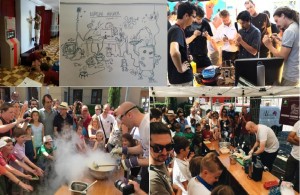 .
Also a great opportunity to meet with our friends from all parts of Switzerland.
.
Also a great opportunity to meet with our friends from all parts of Switzerland.







